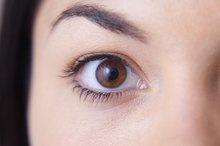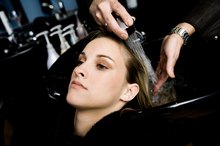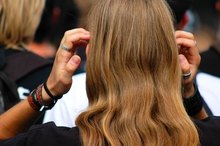What Causes Excess Hair to Fall Out While Brushing?
The average person loses about 100 hairs per day through the natural shedding process. Anything more than 100 hairs is considered excessive. While some hairs get stuck to clothing and furniture, most get tangled up in the hair until they are freed, resulting in a small mass of loose hair each time you brush. Several contributing factors can increase hair loss and breakage including breakage and damage caused by chemicals and abuse, certain medical illnesses and genetic or natural hair loss associated with the aging process.
Breakage and Damage
Healthy hair is elastic. You can stretch it, pull on it, abuse it and style it and it bounces back. The simple act of running a hair brush through damaged hair can cause the hair to snap and fall out.
Chemical services are responsible for the majority of hair loss in the absence of an underlying medical condition. All chemical services including color, perms and relaxers change the appearance and structure of the hair by breaking down and restoring the hair’s natural chemical bonds. Damage always occurs as a result. Hair weakened by chemical damage snaps under daily pressure. This type of hair loss is generally more noticeable right after a chemical service, but you may continue to lose hair for a few months after the service.
- You can stretch it, pull on it, abuse it and style it and it bounces back.
- The simple act of running a hair brush through damaged hair can cause the hair to snap and fall out.
Medical Illness
What Are the Dangers of Relaxing Hair?
Learn More
According to MayoClinic.com, malnutrition, thyroid conditions, diabetes, lupus, hormonal changes, scalp infections, medical treatments and some medications cause:
- excess breakage
- hair loss 2
Talk to your doctor about the possibility of an underlying condition before assuming that your hair loss is part of the natural aging process.
Aging
Everyone loses hair as they age due to the natural aging process. Some lose more than others in a process known as pattern baldness. Both males and females can be affected by pattern baldness, but this type of hair loss is more common in men. According to the International Society of Hair Restoration Surgery, female pattern baldness is not as recognizable as male pattern baldness 3. Females experience a generalized thinning of the hair, whereas men develop a receding hair line and thinning crown.
- Everyone loses hair as they age due to the natural aging process.
- Both males and females can be affected by pattern baldness, but this type of hair loss is more common in men.
Related Articles
References
- William Collier Design: Normal Hair Loss
- MayoClinic.com: Hair Loss Causes
- Fabbrocini G, Cantelli M, Masarà A, Annunziata MC, Marasca C, Cacciapuoti S. Female pattern hair loss: A clinical, pathophysiologic, and therapeutic review. Int J Womens Dermatol. 2018;4(4):203-211. doi:10.1016/j.ijwd.2018.05.001
- Mirmirani P. Managing hair loss in midlife women. Maturitas. 2013;74(2):119-22. doi:10.1016/j.maturitas.2012.10.020
- Trost LB, Bergfeld WF, Calogeras E. The diagnosis and treatment of iron deficiency and its potential relationship to hair loss. J Am Acad Dermatol. 2006;54(5):824-44. doi:10.1016/j.jaad.2005.11.1104
- Park SY, Na SY, Kim JH, Cho S, Lee JH. Iron plays a certain role in patterned hair loss. J Korean Med Sci. 2013;28(6):934-8. doi:10.3346/jkms.2013.28.6.934
- Guo EL, Katta R. Diet and hair loss: effects of nutrient deficiency and supplement use. Dermatol Pract Concept. 2017;7(1):1-10. doi:10.5826/dpc.0701a01
- Vincent M, Yogiraj K. A Descriptive Study of Alopecia Patterns and their Relation to Thyroid Dysfunction. Int J Trichology. 2013;5(1):57-60. doi:10.4103/0974-7753.114701
- Davis SR, Castelo-branco C, Chedraui P, et al. Understanding weight gain at menopause. Climacteric. 2012;15(5):419-29. doi:10.3109/13697137.2012.707385
- Gupta AK, Charrette A. Topical Minoxidil: Systematic Review and Meta-Analysis of Its Efficacy in Androgenetic Alopecia. Skinmed. 2015;13(3):185-9.
- American Academy of Dermatology. Thinning hair and hair loss: Could it be female pattern hair loss?
- Harvard Health Publications. Treating female pattern hair loss - Harvard health.
- U.S. National Library of Medicine. Female pattern baldness.
Writer Bio
Kathy Mayse began her writing career as a reporter for "The Jackson-County Times Journal" in 2001. She was promoted to assistant editor shortly after. Since 2005, she has been busy as a successful freelancer specializing in Web content. Mayse is a licensed cosmetologist with more than 17 years of salon experience; most of her writing projects reflect this experience.








